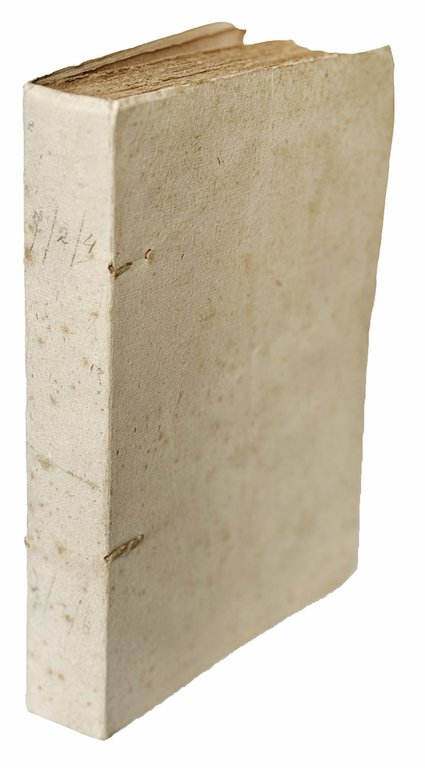

Livres anciens et modernes
BASILE, Giambattista (1566-1632)
La chiaqlira dla banzola o per dir mii fol divers tradutt dal parlar napulitan in lengua bulgnesa per rimedi innucent dla sonn, e dla malincunj dedicà al merit singular dl nobilissm dam d'Bulogna. In Bulogna, per Leli dalla Volp stampador dl'Institut dl Scienzi, MDCCXLLVII
Lelio della Volpe stampatore dell''Istituto delle Scienze, 1777
550,00 €
Govi Libreria Antiquaria
(Modena, Italie)
Les frais d'expédition corrects sont calculés une fois que l'adresse de livraison a été indiquée lors de la création de la commande. Un ou plusieurs modes de livraison sont disponibles à la discrétion du vendeur : standard, express, economy, in store pick-up.
Conditions d'expédition de la Librairie:
Pour les articles dont le prix est supérieur à 300 euros, il est possible de demander un plan de paiement échelonné à Maremagnum. Le paiement peut être effectué avec Carta del Docente, Carta della cultura giovani e del merito, Public Administration.
Les délais de livraison sont estimés en fonction du temps d'expédition de la librairie et de la livraison par le transporteur. En cas de retenue douanière, des retards de livraison peuvent survenir. Les frais de douane éventuels sont à la charge du destinataire.
Pour plus d'informationsMode de Paiement
- PayPal
- Carte bancaire
- Virement bancaire
-
-
Découvrez comment utiliser
votre Carta del Docente -
Découvrez comment utiliser
votre Carta della cultura giovani e del merito
Détails
Description
8vo (199x132 mm). [8], 383, [1] pp. Collation: a4 A-Aa8. Full-page engraved frontispiece by Giuseppe Maria Cantarelli (1736-1744) showing the cultural context in which the work was composed, i.e. a group of women working and chatting together in a family environment. With a woodcut ornament on the title page, a notice to the reader, the table of contents and the final colophon. Modern cardboards (on the flyleaves stamps of a private library “Deciano Deciani Udine”). Uncut, slightly loose, scattered foxing and browning throughout.
Second edition (first: Bologna, Ferdinando Pisarri, 1742), augmented with new verses and allegorical tales, of the translation into the Bologna dialect of Giambattista Basile's collection of fifty Neapolitan fairy tales (Lo cunto de li cunti, first published in Naples in 1634-1637), made by Maddalena and Teresa Manfredi and by Teresa and Angiola Zanotti. Even if the work had a great publishing success and was reprinted several times in the 18th and 19th century, the Chiaqlira dla banzola (“Chatting on the bench”) was published anonymously.
Maddalena (1673-1744) and Maria Teresa (1679-1767) Manfredi were born into a Bolognese petit-bourgeois family. Educated in a convent of tertiary nuns, they excelled in astronomy, mathematics and Latin. As the family gained fame, the two sisters gained popularity. They also helped their brother Eustachio with his Le Effemeridi, a famous astronomical work. Together with the Zanotti sisters, they wrote verses and translations that were quite successful among the Bolognese intellectual bourgeoisie. For this reason, it was not necessary to sign their works; everyone recognised them as their authors.
Maddalena and Maria Teresa Manfredi were closely linked to the Zanotti family, in particular to the daughters of the painter and art historian Giampietro Zanotti: Maria Teresa (b. 1693) and Angiola Anna Maria (b. 1703). They wrote satirical poems in the Bolognese dialect and collaborated with the Manfredi sisters in the translation of the Bertoldo (1740) and Chiaqlira (1742) into the Bolognese dialect.
Canterzani, pp. 293-94; Catalogo Libreria Docet, Bologna, 2023, nr. 267/I; Frati, Opere della bibliografia bolognese, cols. 859 and 7054; University of Bologna, Scienza a due voci. Le donne nella scienza italiana dal Settecento al Novecento, Manfredi Teresa and Zanotti Angiola Anna Maria; La Scuola medica di Domenico Campanacci, Matematiche e poetesse nella Bologna del ‘700, in: “Medicina e cultura”, 1988; G. Fantuzzi, Notizie degli scrittori bolognesi raccolte da Giovanni Fantuzzi, Bologna, 1786, V, pp. 201-2.

